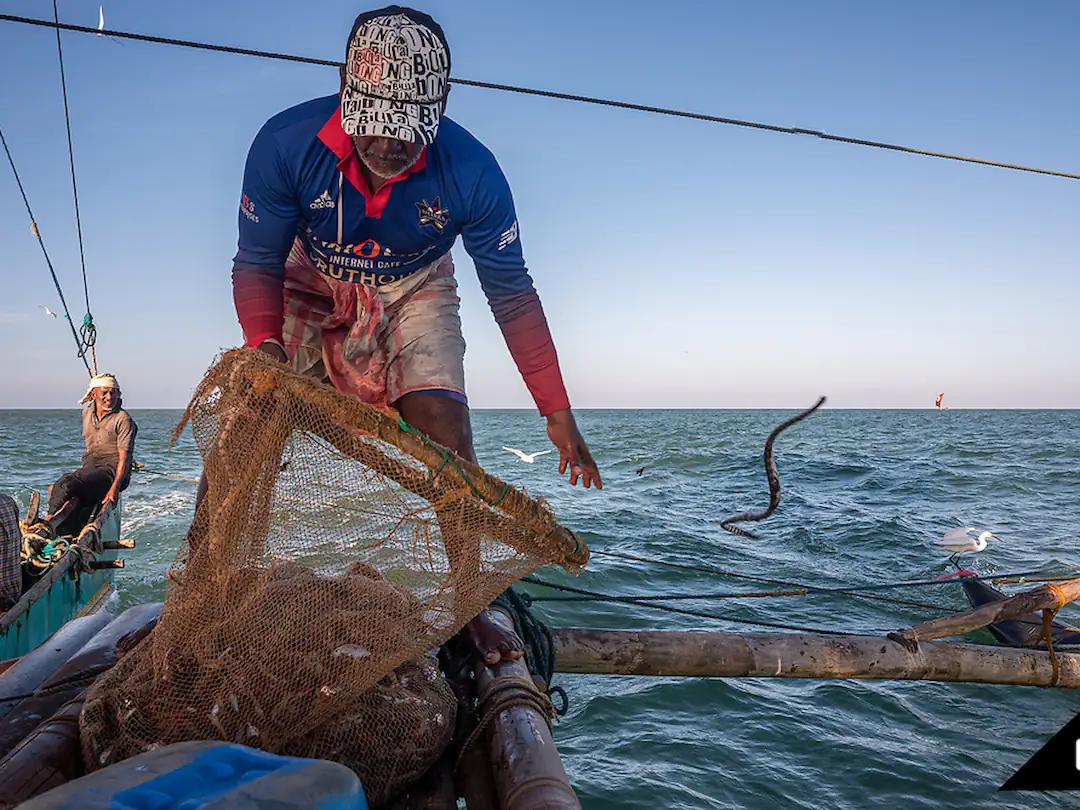
Photo from photoshelter.com
In the Negombo Lagoon, Sri Lanka, shrimp fishing is a way of life. Local fishers have relied on this lagoon’s rich waters for generations to provide for their families, using methods passed down through the years.
But things aren’t as simple as they used to be. As the world changes, so do their practices, with modern boats and gear replacing some of the old ways.
The Fishing Methods in Negombo Lagoon
These simple vessels, carved from the trees surrounding the lagoon, were enough to navigate the shallow waters and make a decent catch. Over time, though, things began to change. As the demand for shrimp grew and technology progressed, the introduction of modern boats became inevitable. Now, alongside the classic dugout canoes, you’ll find fiberglass boats cruising the same waters, equipped with better engines and more storage space.
Back in the day, fishers relied on basic tools like trammel nets, brush piles, cast nets, drag nets, and stake-seine nets. These were tried and tested methods that brought in a steady supply of shrimp and fish.
But as fishers upgraded their boats, the gear followed suit. Modern versions of these tools now feature stronger materials and improved designs, allowing for more efficient operations.
Fishing Gears Overview
Trammel nets are by far the most popular choice for fishermen in Negombo Lagoon. They are layered with different mesh sizes, making them great for catching a variety of fish and shrimp. Over time, these nets have been modernized with stronger, more durable fibers, helping fishers haul in larger catches without damaging the nets.
Drag nets, on the other hand, have become a bit controversial. While they’re incredibly effective, especially in scooping up shrimp from the shallower parts of the lagoon, they’ve faced stricter regulations lately. Why? Because they tend to catch everything in their path, including juvenile shrimp that haven’t had a chance to mature.
Stake-seine nets, fixed at specific lagoon spots, are highly effective for targeting shrimp during their migration. Cast nets, though used less frequently, are still a staple for many fishers, especially those working solo or in smaller boats.
https://www.youtube.com/watch?v=2FH5dWhOvCY
Catch Rates and Annual Production
Over the past few years, there’s been a noticeable uptick in the catch rates for shrimp in the Negombo Lagoon, and much of this improvement can be traced back to better fishing gear and more efficient practices. Fishers are constantly tweaking and upgrading their equipment, making their operations smoother and more productive.
Let’s break it down: trammel nets, which have always been a favorite, now bring in around 5.5 to 6 kg per operation, solid gains compared to previous years. Brush piles, another common method, have also improved, with fishers hauling in 7.5 to 8 kg per session. Cast nets, though less efficient, have seen a slight bump as well, now averaging between 0.7 and 0.8 kg peruse.
Drag nets, which are often used for bigger hauls, have benefited greatly from modern materials and designs, now pulling in about 16 to 17 kg per operation. But the real winner here is the stake-seine net, a gear type that continues to outperform others, with fishers bringing in between 26.5 and 28 kg per operation.
Total Annual Catch in Recent Years
However, the total annual catch in the lagoon tells a more complex story. While individual operations might improve, the total yearly catch isn’t as clear. The numbers have fluctuated over the last few years, largely due to varying levels of fishing pressure and shifting environmental conditions. On an average year, the total catch hovers between 950 to 1,100 metric tons, but some years dip below or rise above this range.
The fishing economy feels the effects of these fluctuations. Local markets thrive when the catch is good, and fishers can expect higher incomes. However, the whole system feels the strain when environmental factors like unpredictable weather patterns or changes in the lagoon’s water quality cause the catch to dip.
Economics of Shrimp Fishing
Over the years, inflation and market changes have forced fishers to adapt their practices and financial expectations. If you look at the numbers, income per fishing operation has slightly risen, but it’s still highly dependent on the method used.
Take stake-seine nets, for instance—they’re still the most profitable,
Fishers using cast nets, for example, see much smaller returns. Trammel net fishers fare better.( Coulntd get the exact amounts because there is a massive gap in information, but this is the general story)
Challenges in Balancing Fishing and Conservation
As fishing efforts increase to meet demand and make up for the leaner years, the pressure on the lagoon’s resources mounts. The more we push the lagoon to produce, the closer we reach the point where its resources can’t bounce back.
Sustainable practices are no longer just a nice idea but necessary. Without careful management, fishers could end up depleting the very resources they rely on.
But that’s easier said than done, especially when fishers are under constant economic pressure to maximize their catch.
Community-Based Management
The Role of Kattudel Fisheries Societies
In Negombo Lagoon, the Kattudel Fisheries Societies (KFS) have long played a central role in managing fishing rights. These societies, deeply rooted in the local fishing culture, are tasked with overseeing the fair use of stake-seine nets, one of the most effective tools for shrimp fishing in the lagoon.
Membership is exclusive—passed down through generations—ensuring that only certain families hold the right to fish with these nets. It’s a system that has worked for decades, balancing the need for economic survival with the fair distribution of fishing opportunities. However, the modern world has introduced new challenges that are stretching these societies to their limits.
One of the biggest issues facing the KFS today is the rising tension over resource allocation. The societies still use a lottery system to assign fishing spots, which, in theory, ensures fairness.
Every year, members gather to draw lots, determining which fishers get access to the best locations for their stake-seine nets. However, with more fishers vying for the same resources, disputes are becoming more common. As the fish population comes under pressure from overfishing and environmental changes, the stakes are higher, and conflicts arise more frequently. The very system designed to keep peace is now strained as fishers argue over dwindling resources.
Fishing Method Efficiency and Regulation
In recent years, researchers and fishers alike have turned to modern models to analyze which methods produce the best results without harming the ecosystem. Stake-seine nets, unsurprisingly, continue to rank among the most efficient, especially for shrimp.
They’re highly selective and target pre-adult shrimp migrating from the lagoon to the sea, making them a reliable choice for fishers looking to maximize their catch.
Trammel nets and drag nets also perform well, but with a catch: they’re not as selective and can inadvertently catch juvenile shrimp, which poses a risk to the long-term sustainability of the fishery.
This is where government regulation steps in to protect the future of the lagoon’s shrimp population; stricter rules have been put in place, especially concerning drag nets. These regulations are designed to limit the number of juvenile shrimp being caught before they have a chance to mature and reproduce.
In theory, this helps maintain the shrimp population for future generations. However, enforcement is often inconsistent. Some fishers abide by the rules, understanding that a sustainable fishery benefits everyone, while others push the limits, driven by immediate economic pressures.
The Future of Shrimp Fishery in Negombo Lagoon
The future of shrimp fishing in Negombo Lagoon faces a growing number of threats, one of the biggest being overfishing. As more fishers cast their nets in the lagoon, the pressure on the ecosystem keeps increasing.
It’s not just about catching more shrimp.
There’s a ripple effect on the entire food chain. Overfishing means fewer shrimp make it to adulthood, which not only hurts the shrimp population but also affects the other species that depend on them. Add environmental degradation to the mix—like pollution, mangrove destruction, and changing water quality—and it’s a recipe for disaster.
The Need for Sustainable Management Practices
One of the most effective ways to ensure shrimp stocks remain healthy is by introducing and enforcing gear restrictions and catch limits. This might sound restrictive, but it’s essential for preventing the kind of overfishing that’s already taking its toll.
Gear like drag nets, while effective at bringing in large hauls, can be damaging to the ecosystem, especially when they scoop up juvenile shrimp that haven’t had the chance to reproduce.
Of course, none of these efforts can succeed without collaboration. The local fishing communities, government agencies, and conservation groups must work together to protect the lagoon.
Fishers understand the lagoon better than anyone—they know when stocks are dwindling and when the environment is changing. Their input is crucial in shaping policies that are both effective and fair.
On the other hand, government agencies can provide the enforcement needed to ensure regulations are followed, while conservation groups can offer the expertise to make sure the lagoon’s unique ecosystem is protected.
The shrimp fishery in the Negombo Lagoon, located on the west coast of Sri Lanka, is a prime example of how artisanal fisheries continue to thrive despite modern pressures.
This coastal lagoon, close to Colombo, has long been home to a vibrant fishing community that relies on traditional methods such as trammel nets, stake nets, and cast nets. These techniques, combined with modern practices like trawling and the use of drag nets, help fishers target valuable species like Penaeus indicus and Metapenaeus dobsoni.
However, this lagoon on the west coast is facing increasing challenges. Overfishing, environmental degradation, and the pressures on fishery resources have put a strain on the delicate ecosystem of the Negombo estuary.
The introduction of improved fishing gears, such as the brush pile technique and stake-seine nets, has provided some relief, but sustainable practices are more important than ever.
Efforts led by local fishing communities, including the Kattudel fishery, have been crucial in promoting equity sharing and resource management in this artisanal fishery.
As shrimp fisheries in the region continue to target penaeid species, protecting this estuary in Sri Lanka will require collaboration, careful management, and a commitment to sustainability. The future of shrimp fishery in the Negombo Lagoon depends on these efforts to safeguard both the livelihood of Sri Lankan fishers and the health of the lagoon’s coastal ecosystem.
